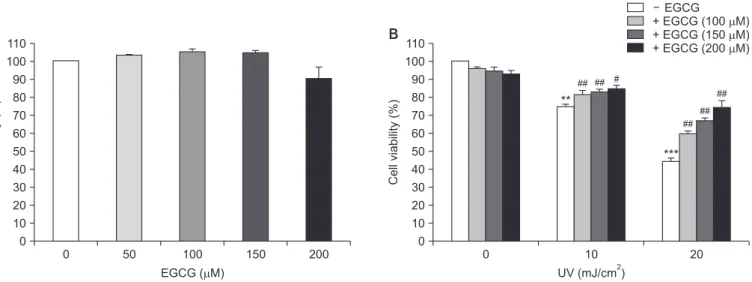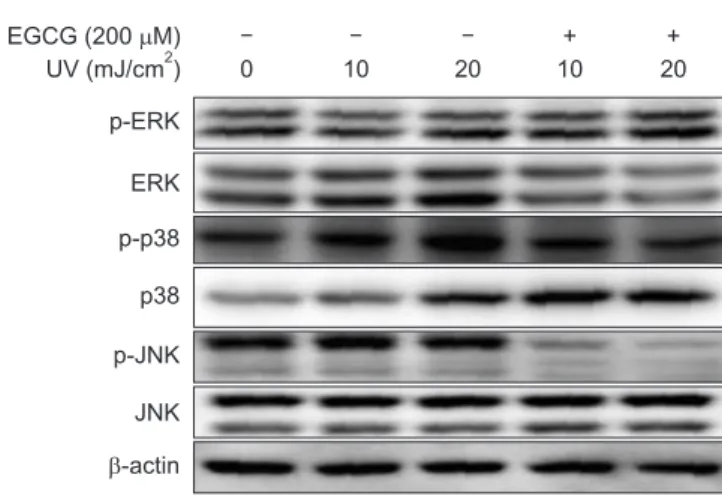Introduction Introduction
Ultraviolet (UV) radiation present in natural sunlight and
therapeutic artificial devices is a key human health concern. UV irradiation has been implicated in the development of various cancers in humans, including skin cancer, basal and squamous Int J Oral Biol 45:179-189, 2020
pISSN: 1226-7155 • eISSN: 2287-6618 https://doi.org/10.11620/IJOB.2020.45.4.179
Green tea polyphenol (–)-epigallocatechin-3-gallate prevents ultraviolet-induced apoptosis in PC12 cells
Su-Mi Woo 1† , Yoon-Jung Kim 1† , Bangrong Cai 2† , Sam-Young Park 1 , Young Kim 3 , Ok Joon Kim 3 , In-Chol Kang 4 , Won-Jae Kim 1 *, and Ji-Yeon Jung 1 *
1 Department of Oral Physiology, Dental Science Research Institute, School of Dentistry, Chonnam National University, Gwangju 61186, Republic of Korea
2 School of Pharmacy, Henan University of Traditional Chinese Medicine, Zhengzhou 450008, China
3 Department of Oral Pathology, Dental Science Research Institute, School of Dentistry, Chonnam National University, Gwangju 61186, Republic of Korea
4 Department of Oral Microbiology, Dental Science Research Institute, School of Dentistry, Chonnam National University, Gwangju 61186, Republic of Korea
Green tea polyphenol (–)-epigallocatechin-3-gallate (EGCG) is a potent antioxidant with protective effects against neurotoxicity. However, it is currently unclear whether EGCG protects neuronal cells against radiation-induced damage. Therefore, the objective of this study was to investigate the effects of EGCG on ultraviolet (UV)-induced oxidative stress and apoptosis in PC12 cells. The effects of UV irradiation included apoptotic cell death, which was associated with DNA fragmentation, reactive oxygen species (ROS) production, enhanced caspase-3 and caspase-9 activity, and poly (ADP-ribose) polymerase cleavage. UV irradiation also increased the Bax/Bcl-2 ratio and mitochondrial pathway-associated cytochrome c expression. However, pretreatment with EGCG before UV exposure markedly decreased UV-induced DNA fragmentation and ROS production. Furthermore, the UV irradiation- induced increase in Bax/Bcl-2 ratio, cytochrome c upregulation, and caspase-3 and caspase-9 activation were each ameliorated by EGCG pretreatment. Additionally, EGCG suppressed UV-induced phosphorylation of p38 and rescued UV-downregulated phosphorylation of ERK. Taken together, these results suggest that EGCG prevents UV irradiation- induced apoptosis in PC12 cells by scavenging ROS and inhibiting the mitochondrial pathways known to play a crucial role in apoptosis. In addition, EGCG inhibits UV-induced apoptosis via JNK inactivation and ERK activation in PC12 cells. Thus, EGCG represents a potential neuroprotective agent that could be applied to prevent neuronal cell death induced by UV irradiation.
Keywords: Apoptosis, Epigallcatechin, PC12 cells, Radiation
Received November 3, 2020; Revised November 10, 2020; Accepted November 11, 2020
*Correspondence to: Ji-Yeon Jung, E-mail: jjy@jnu.ac.kr https://orcid.org/0000-0002-4419-8077
*Correspondence to: Won-Jae Kim, E-mail: wjkim@jnu.ac.kr https://orcid.org/0000-0001-6549-744X
† Su-Mi Woo, Yoon-Jung Kim, and Bangrong Cai contributed equally to this work.
Copyright © The Korean Academy of Oral Biology
CC



